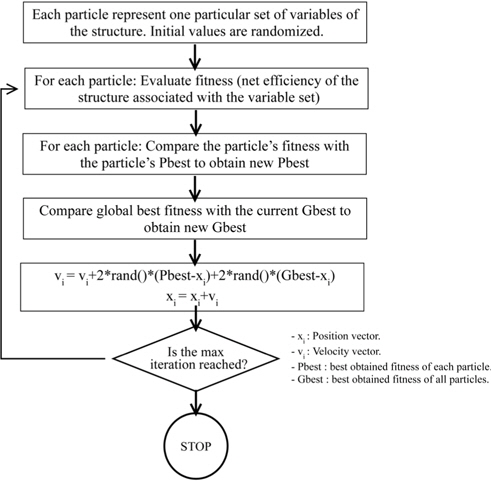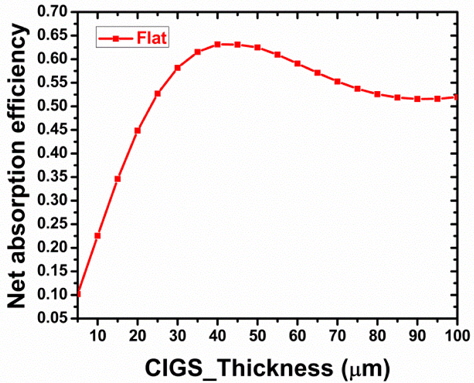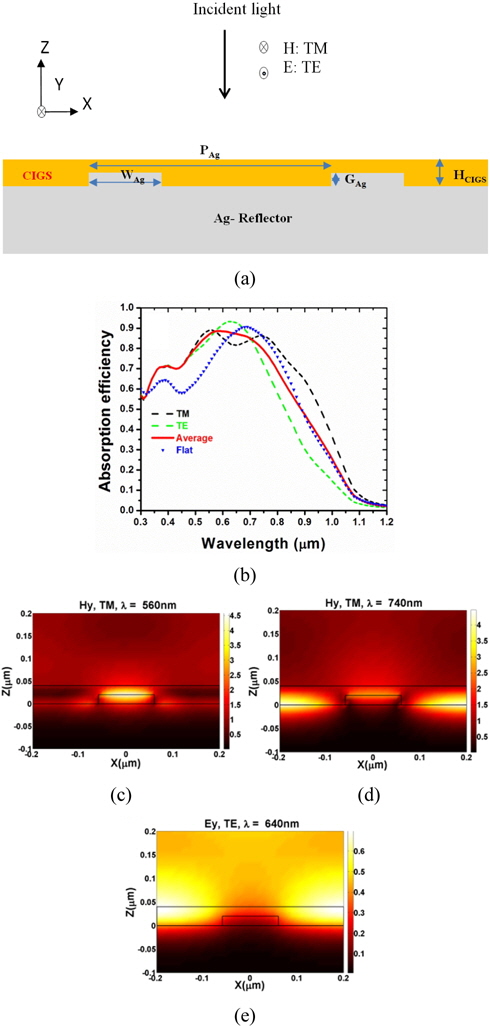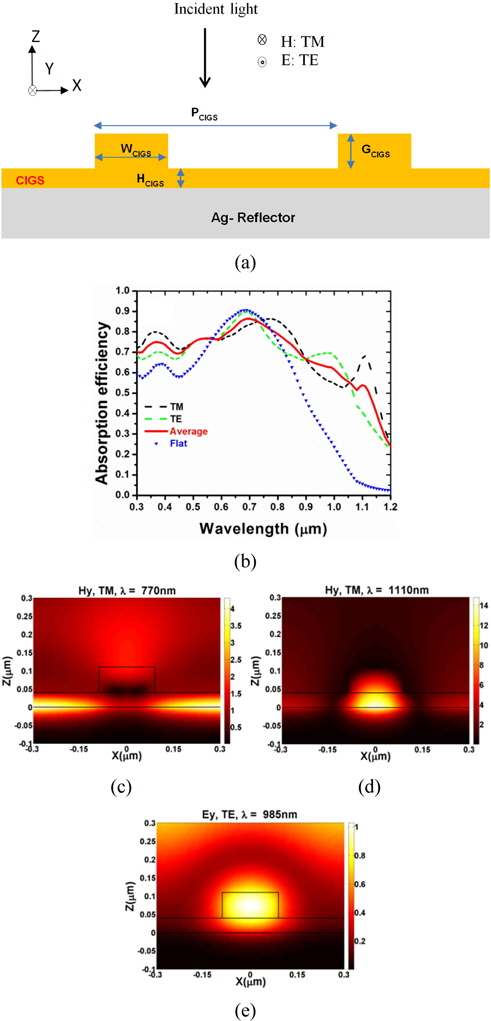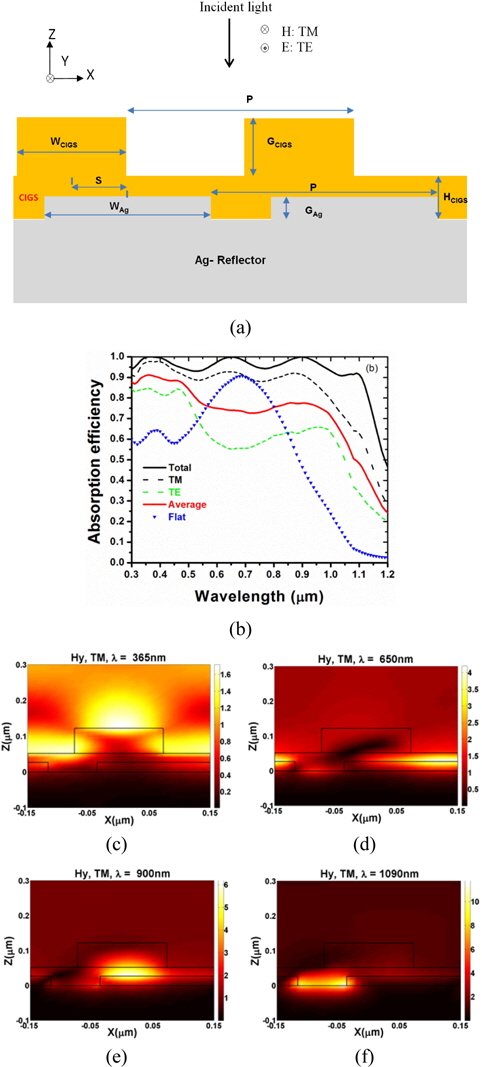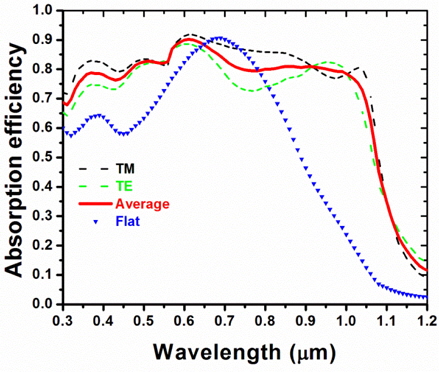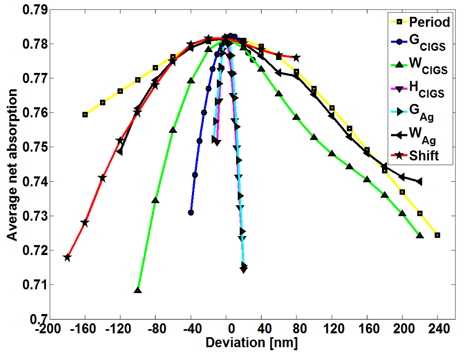



Among various thin film solar cells progressing more rapidly, the polycrystalline chalcopyrite CuIn1-xGaxSe2 (CIGS) is a one of the most attractive candidates due to low material cost, long-term thermal stability, large-scale and flexible manufacturing, and superior conversion efficiency [1-4]. In particular, compared to other thin film solar cells based on a-Si or polymers, the highest conversion efficiency of up to 20.3% [5] is a result of the unique material properties of CIGS as the I-III-VI2 semi-conducting compounds, in which the bandgap energy range can be controlled by ratio x≡Ga/(In+Ga) [4, 6-7].
Recently, one of most attractive methods for enhancing light trapping in thin film solar cells is to utilize the effect of surface plasmon polaritons (SPPs) by applying metallic nanostructures [8-12]. The excited SPPs cause strong nearfield enhancement and increase optical path length via broad-angle light scattering. Because the dissipation energy is proportional to the electric field intensity, the strongly confined energy at the interface between metallic element and active medium boost solar cell efficiency. For example, metallic nanogratings placed at the bottom of the active layer [11-12] enable the broadband and polarization insensitive absorption by taking advantage of effective coupling to SPP (plasmonic) or photonic modes. Meanwhile, metallic nanogratings or nanoparticles placed at the top surface of the active layer also increase absorption performance although the effect can occur only at certain wavelengths and a considerable amount of incident light is blocked by metallic elements. To further improve absorption performance compared to these single nanogratings based structures, recently, there has been growing interest in using dual grating structures to enhance absorption thin film solar cells [13-16]. These structures will enhance the coupling between incoming light and different types of resonance modes, by changing geometry parameters of dual grating structures (top and bottom), resulting in an overall broadband absorption enhancement.
Most previous works on optimization of grating structures used a parametric scan method to enhance absorption [10, 12-13]. It becomes a much more difficult and time-consuming process when the number of relevant geometric parameters increases. In this study, we demonstrate the maximal utilization of the ‘particle swarm optimization (PSO)’ method for a thin film CIGS solar cell with the dual nanogratings composed of a top CIGS grating and a bottom Ag grating, which have 7 degrees of freedom (active layer thickness, period, each thickness and width of top and bottom gratings, and the lateral shift between both gratings). The PSO method, developed by Kennedy and Eberthart [17], was a robust stochastic optimization technique. Inspired by social behavior of bird flocks or fish schools, PSO has been used for various design optimization problems, including diffractive grating structures [18-20]. PSO is particularly well suited to the optimization of solar cell designs due to the fact that PSO is a metaheuristic algorithm - no assumption is necessary on the topology of the search space - which can be quite complicated when complex structures are employed to maximize performance. The flowchart of the PSO algorithm employed in this paper is shown in Fig. 1.
Due to well-spaced and well-defined absorption peaks obtained from PSO, the optimized shifted dual grating structure exhibits the broadband absorption at the wide range wavelengths from 300 nm to 1200 nm, with the net absorption of
II. DEVICE ARCHITECTURE AND NUMERICAL METHOD
A thin film solar cell device using shifted dual grating structure was designed with the silver grating in the bottom and the CISG grating on the top. The WAg and GAg are the width and thickness of the silver grating. The WCIGS and GCIGS are the width and thickness of the CIGS grating. In all calculations, the silver reflector thickness is 100 nm and the incident light is normal to the surface. The optical constants of CuIn1-xGaxSe2 (x = 0.31) and silver are extracted from Ref. [7] and [21], respectively. The absorption efficiency (
III. OPTIMIZATION OF SINGLE GRATING STRUCTURES
In this section, we examine absorption performances of two single (top and bottom) grating based structures by using ‘parametric scan’ as the optimization method under both polarizations. We fixed the CIGS layer thickness to HCIGS = 40 nm, at which net absorption has a highest value of
The schematic of bottom grating structure is shown in Fig. 3(a). For the purpose of maximizing the net absorption efficiency, we employed the parametric scan for period range of PAg from 100 to 900 nm with 100 nm intervals, fill factor range of FAg from 0.1 to 0.7 with 0.1 intervals, and grating thickness range of GAg from 5 to 35 nm with 5 nm intervals. This means that calculations of 9×7×7 times are conducted. The optimized averaged
The optimization process using the parametric scan was also conducted for the top grating, while keeping the similar parametric ranges to the bottom grating; period range of PCIGS from 100 to 900 nm with 100 nm intervals, fill factor range of FCIGS from 0.1 to 0.7 with 0.1 intervals, and grating thickness range of GAg from 10 to 70 nm with 5 nm intervals. The schematic of top grating structure is shown in Fig. 4(a). At PCIGS = 600 nm, FCIGS = 0.3 (WCIGS = 180 nm), and GCIGS = 70 nm, the optimized averaged
Now, we address the dual grating structures. Under the limitation of the design tools, we restricted the period of the top and bottom gratings to be the same. The double grating structure has 7 degrees of freedom; active layer thickness (HCIGS), period (P), each thickness (GCIGS, GAg) and width (WCIGS , WAg) of gratings, and the lateral shift (S) between both gratings. To reliably, albeit roughly, estimate the global optimization, the parametric scan can be attempted, similar to the single grating case of previous section. Assuming that each parameter has 10 steps, total number of iterations would be 107 (10 million); it is a prohibitive value which is highly time-consuming.
Also, separated tuning of each parameter, as done in [13], is not the answer; changing one design parameter would almost certainly shifts the local optimal value of all of the remaining parameters, rendering the search for the global optimum value impossible. Indeed, in [22], virtually any absorption in the active layer was not obtained from 700 nm to near infrared, where strong plasmonic modes can be potentially excited.
4.1. PSO Optimization of TM Polarized Performance
We employ the PSO method to solve the problem previously mentioned, and we consider the net absorption under TM polarization as the fitness function for the PSO algorithm. In PSO algorithm, tuning of different modes would involve tuning of the resonance wavelengths for maximizing broadband absorption in active layer, while minimizing resistive losses by metallic layer and reflection. Due to the highly absorbing nature of CIGS in the broadband wavelength ranges, a determining factor of absorption performance is not the number of resonance modes, but the spacing of prevailing resonance modes so that it is possible to populate the broader solar spectrum in contrast with Si-based solar cells. For example, resonance width at 90% of peak absorption is roughly 200 nm and remains relatively constant in Fig. 3(b) and Fig. 4(b), which mean the full absorption spectrum from 300 nm to 1200 nm range can be divided into 4 resonance peaks with negligible reflective loss when we assume any optimal situation. Each well-defined and well-spaced peak requires at least two degrees of freedom - one to tune its maximum absorption, and one to tune its peak position (wavelength). As such, for our proposed device with 7 degrees of freedom, one can expect an absorption spectrum with at least three well-spaced and well-defined absorption peaks. Indeed, PSO result showed four resonance peaks with spacing from 190 nm to 295 nm, fully populated the 300 nm to 1200 nm spectrum, as discussed later.
First, we used the PSO algorithm to optimize the dual grating structure (Fig. 5 (a)) under TM polarization only. The optimized geometry parameters are as follows; HCIGS = 52 nm, P = 300 nm, GCIGS = 70 nm, WCIGS = 145 nm, GAg = 27 nm, WAg = 220 nm, and S = 74 nm. The corresponding absorption efficiency in Fig. 5(b) shows ultra broadband enhancement. An important fact is that the absorption capability of CIGS, as the most active medium, is comparatively much lower at longer wavelengths [7], and thus effective light trapping mechanism is required to achieve high absorption performance, which plasmonic modes are capable of. Indeed, in our optimized structure, three of four absorption peaks pertaining to broadband absorption enhancement are attributed to SPP modes excited at longer wavelength ranges. We present here the total absorption spectrum, including metal absorption (black solid line in the Fig. 5(b)). These SPP modes cause strong field confinement at the interface between Ag and CIGS, as shown in Fig. 5(d), 5(e), and 5(f). The other corresponds to waveguide mode (Fig. 5(c)). In the Table 1, the net absorption efficiency is

Net absorption efficiency of PSO optimization dual grating structure optimized for TM polarization
4.2. PSO Optimization of Simultaneous TE and TM Polarized Performance
Next, we applied the PSO algorithm to optimize the dual grating structure under non-polarization, in other words, we consider the average of the net absorption under TE and TM polarization as the fitness function for the PSO algorithm. The optimized geometry has HCIGS = 39 nm, P = 570 nm, GCIGS = 70 nm, WCIGS = 131 nm, GAg = 18 nm, WAg = 129 nm, and S = 187 nm. The optimized net absorption efficiency of 78.1% corresponds to improvement of 23.5% compared to flat structure as seen in Table 2. The absorption performance is somewhat smaller than the only TM optimized case with

Net absorption efficiency of PSO optimization dual grating structure optimized for both TM and TE polarizations
A design with larger number of degrees of freedom would be more capable of fully optimizing such a system. Specifically, in order to realize a structure with four well-defined and well-spaced absorption peaks under both TE and TM polarizations, a system with more degrees of freedom would be required. One might note that it is possible to realize such a system in 2D asymmetrical dual grating [24], meanwhile, in such large numbers of optimization parameters, any kind of brute force parametric scanning would not be practical at all.
In practical applications, the short circuit current density is one of the popular indicators of solar cell performance in terms of optical absorption, assuming that each absorbed photon creates an electron-hole pair that gets collected. In this work, we expressed the short circuit current density (
where,
The short circuit current density of the PSO optimization dual grating structure and the flat structure with the equal volume of CIGS is shown in the Table 3. In the case of TE polarization, the

Short circuit current density Jsc of of PSO optimization dual grating structure optimized for both TM and TE polarizations
In practical device fabrication, some geometry parameters may not match with optimized parameters. In order to investigate the effective tolerance of geometry parameters, we examined the sensitivity of absorption performance to varying geometry parameters around the optimal condition (Fig. 7). The optimized structure is rather insensitive to deviations of its design parameters. For P, WCIGS , WAg and S, an error of 20 nm results in a reduction in the averaged net absorption of less than 0.3% compared with optimal value. For GCIGS, GAg and HCIGS, an error of 5 nm results in a reduction in the average net absorption of 0.8%. In fabrication, these tolerances of our optimized design structure are suitable with nanofabrication equipment [25].
In conclusion, we investigated the optimization capability of PSO in thin film CIGS solar cell with dual gratings (composed of top dielectric and bottom metal gratings). The optimized structure produces strong and ultra broadband absorption in the range of 300~1200 nm. PSO algorithm allows the formation of well-spaced and well-defined absorption peaks, as the results of a combination of SPPs and photonic modes induced by metal and dielectric gratings. The potential of PSO is strikingly useful in structure with the larger number of degree of freedom, meanwhile conventional optimization method such as parametric scan requires a prohibitive calculation time. Under only TM and both polarization, the PSO optimized net absorption of

